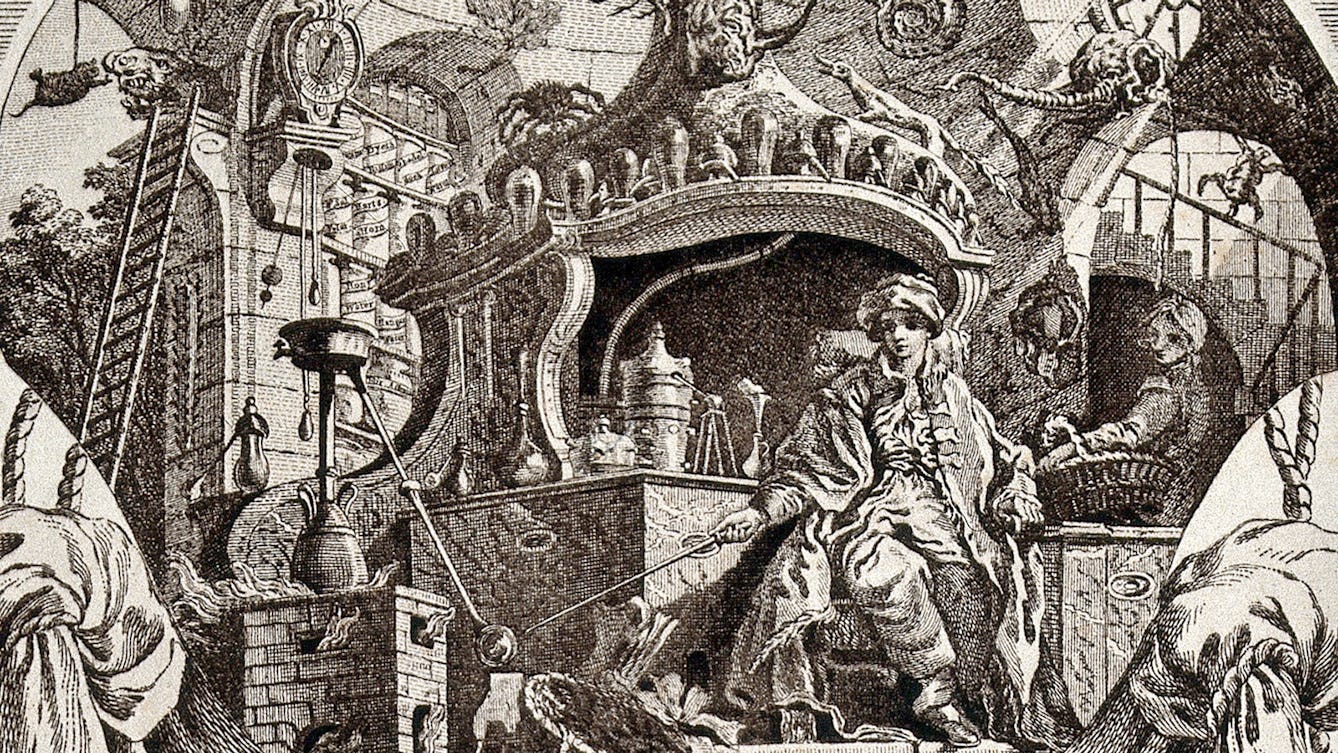Stories

- In pictures
The evolution of war-zone medicine
The need to deal with battlefield injuries has led to inventive designs for extreme situations. Find out how camel-drawn ambulances and flat-pack hospitals have helped casualties survive.

- Article
Illuminated manuscripts, illuminating medicines
From rare bugs to exorbitantly priced plant parts, find out more about the artistic and medical uses of pigments from the past.

- Article
Interpreting the Ayurvedic Man
A British Sign Language video is the latest interpretation of an unique 18th-century Nepali painting about Ayurvedic medicine.

- Article
The chymist’s trade card
An 18th-century trade card reveals far more than its owner may have intended.
Catalogue
- Archives and manuscripts
Italian Medical Miscellany, 18th Century
Date: 3 August 1743Reference: MS.5863/7Part of: Italian Medical Miscellany, 18th Century- Archives and manuscripts
Italian Medical Miscellany, 18th Century
Date: 1604-1805Reference: MS.5863/17Part of: Italian Medical Miscellany, 18th Century- Archives and manuscripts
Italian Medical Miscellany, 18th Century
Date: 3 July 1743Reference: MS.5863/6Part of: Italian Medical Miscellany, 18th Century- Archives and manuscripts
Italian Medical Miscellany, 18th Century
Date: 18 September 1743Reference: MS.5863/13Part of: Italian Medical Miscellany, 18th Century- Archives and manuscripts
Italian Medical Miscellany, 18th Century
Date: 5 August 1743Reference: MS.5863/8Part of: Italian Medical Miscellany, 18th Century




![Atropa belladonna L. Solanaceae. Deadly nightshade. Dwale. Morella, Solatrum, Hound's berries, Uva lupina, Cucubalus, Solanum lethale. Atropa derives from Atropos the oldest of the three Fates of Greek mythology who cut the thread of Life (her sisters Clotho and Lachesis spun and measured the thread, respectively). belladonna, literally, means 'beautiful lady' and was the Italian name for it. Folklore has it that Italian ladies put drops from the plant or the fruits in their eyes to make themselves doe-eyed, myopic and beautiful. However, this is not supported by the 16th and 17th century literature, where no mention is ever made of dilated pupils (or any of the effects of parasympathetic blockade). Tournefort (1719) says 'The Italians named this plant Belladonna, which in their language signifies a beautiful woman, because the ladies use it much in the composition of their Fucus [rouge or deceit or cosmetic] or face paint.' Parkinson says that the Italian ladies use the distilled juice as a fucus '... peradventure [perhaps] to take away their high colour and make them looke paler.' I think it more likely that they absorbed atropine through their skin and were slightly 'stoned' and disinhibited, which made them beautiful ladies in the eyes of Italian males. Distribution: Europe, North Africa, western Asia. Culpeper (1650) writes: 'Solanum. Nightshade: very cold and dry, binding … dangerous given inwardly … outwardly it helps the shingles, St Antonie's Fire [erysipelas] and other hot inflammation.' Most of the 16th, 17th and 18th century herbals recommend it topically for breast cancers. Poisonous plants were regarded as 'cold' plants as an excess of them caused death and the body became cold. They were regarded as opposing the hot humour which kept us warm and alive. Poultices of Belladonna leaves are still recommended for muscle strain in cyclists, by herbalists. Gerard (1633) writes that it: 'causeth sleep, troubleth the mind, bringeth madnesse if a few of the berries be inwardly taken, but if more be taken they also kill...'. He was also aware that the alkaloids could be absorbed through the skin for he notes that a poultice of the leaves applied to the forehead, induces sleep, and relieves headache. The whole plant contains the anticholinergic alkaloid atropine, which blocks the peripheral actions of acetylcholine in the parasympathetic nervous system. Atropine is a racemic mixture of d- and l- hyoscyamine. Atropine, dropped into the eyes, blocks the acetylcholine receptors of the pupil so it no longer constricts on exposure to bright light - so enabling an ophthalmologist to examine the retina with an ophthalmoscope. Atropine speeds up the heart rate, reduces salivation and sweating, reduces gut motility, inhibits the vertigo of sea sickness, and is used to block the acetylcholine receptors to prevent the effects of organophosphorous and other nerve gas poisons. It is still has important uses in medicine. Atropine poisoning takes three or for days to wear off, and the hallucinations experienced by its use are described as unpleasant. We have to be content with 'madness', 'frenzie' and 'idle and vain imaginations' in the early herbals to describe the hallucinations of atropine and related alkaloids as the word 'hallucination' in the sense of a perception for which there is no external stimulus, was not used in English until 1646 (Sir T. Browne, 1646). It is a restricted herbal medicine which can only be sold in premises which are registered pharmacies and by or under the supervision of a pharmacist (UK Medicines and Healthcare Products Regulatory Agency (MHRA)). Photographed in the Medicinal Garden of the Royal College of Physicians, London.](https://iiif.wellcomecollection.org/image/B0008945/full/282%2C/0/default.jpg)
![Cistus incanus ssp creticus Juss. Cistaceae. Rock Rose. Distribution: Crete. Interesting symbiosis with fungus called Tuber melanosporum which increases nutrient absorption for the plant and inhibits growth of other plants in the vicinity. It is a source of the resin ‘labdanum’ (a.k.a. ‘ladanum’) used in perfumes (similar smell to ambergris), as is Cistus ladanifer. It has no medical uses now, and such use was dwindling even in the 18th century. In the 16th century (Henry Lyte’s 1575 translation of Rembert Dodoen’s Cruydeboeck of 1554) its uses were described (directly copied from Dioscorides’ Materia Medica (70AD)) as: ‘Ladanum dronketh with olde wine, stoppeth the laske [periods], and provoketh urine. It is very good against the hardness of the matrix or mother [uterus] layde to in the manner of a pessarie, and it draweth down the secondes or afterbirth, when it is layde upon quicke coles [hot coals], and the fumigation or parfume thereof be received up into the body of women. // The same applied to the head with Myrrhe and oyle of Myrrhe, cureth the scurffe, called Alopecia, and keepeth the heare [hair] from falling of [sic], but whereas it is already fallen away, it will not cause the heare to growe agayne. // ...' and goes on in this vein about its uses for pain in the ears, and removing sores and scars and other things. Photographed in the Medicinal Garden of the Royal College of Physicians, London.](https://iiif.wellcomecollection.org/image/B0008969/full/282%2C/0/default.jpg)
![Pulsatilla vulgaris Mill. Ranunculaceae Distribution: Europe. Lindley (1838) and Woodville (1790) knew this as Anemone pulsatilla, the common name being Pasque (Easter) Flower. At the end of the 18th century it was recommended for blindness, cataracts, syphilis, strokes and much more, treatments which, as was clear to physicians at the time, were valueless. Gerard (1633) writes: ‘They serve only for the adorning of gardens and garlands, being floures of great beauty’. It is in the buttercup family, Ranunculaceae, all members of which are poisonous. It was recommended, by mouth, for ‘obstinate case of taenia’ (tapeworms). One hopes it was more toxic to the worm than the patient. Flowers with a central disc and radiating florets were regarded as being good for eye complaints under the Doctrine of Signatures. Porta (1588) writes (translated): ‘Argemone [Papaver argemone], and anemone, have flowers of this shape, from this they cure ulcers and cloudiness of the cornea’. There were occupational diseases even before there were words like pneumoconiosis, and Lindley writes that ‘the powder of the root causes itching of the eyes, colic and vomiting, if in pulverising it the operator do not avoid the fine dust which is driven up.’ Photographed in the Medicinal Garden of the Royal College of Physicians, London.](https://iiif.wellcomecollection.org/image/B0009141/full/282%2C/0/default.jpg)
![Pulsatilla vulgaris Mill. Ranunculaceae. Pasque flower. Distribution: Europe. Lindley (1838) and Woodville (1790) knew this as Anemone pulsatilla, the common name being Pasque (Easter) Flower. At the end of the 18th century it was recommended for blindness, cataracts, syphilis, strokes and much more, treatments which, as was clear to physicians at the time, were valueless. Gerard (1633) writes: ‘They serve only for the adorning of gardens and garlands, being floures of great beauty’. It is in the buttercup family, Ranunculaceae, all members of which are poisonous. It was recommended, by mouth, for ‘obstinate case of taenia’ (tapeworms). One hopes it was more toxic to the worm than the patient. Flowers with a central disc and radiating florets were regarded as being good for eye complaints under the Doctrine of Signatures. Porta (1588) writes (translated): ‘Argemone [Papaver argemone], and anemone, have flowers of this shape, from this they cure ulcers and cloudiness of the cornea’. There were occupational diseases even before there were words like pneumoconiosis, and Lindley writes that ‘the powder of the root causes itching of the eyes, colic and vomiting, if in pulverising it the operator do not avoid the fine dust which is driven up.’ Photographed in the Medicinal Garden of the Royal College of Physicians, London.](https://iiif.wellcomecollection.org/image/B0009140/full/600%2C/0/default.jpg)
![Pulsatilla vulgaris Mill. Ranunculaceae Pasque flower. Distribution: Europe. Lindley (1838) and Woodville (1790) knew this as Anemone pulsatilla, the common name being Pasque (Easter) Flower. At the end of the 18th century it was recommended for blindness, cataracts, syphilis, strokes and much more, treatments which, as was clear to physicians at the time, were valueless. Gerard (1633) writes: ‘They serve only for the adorning of gardens and garlands, being floures of great beauty’. It is in the buttercup family, Ranunculaceae, all members of which are poisonous. It was recommended, by mouth, for ‘obstinate case of taenia’ (tapeworms). One hopes it was more toxic to the worm than the patient. Flowers with a central disc and radiating florets were regarded as being good for eye complaints under the Doctrine of Signatures. Porta (1588) writes (translated): ‘Argemone [Papaver argemone], and anemone, have flowers of this shape, from this they cure ulcers and cloudiness of the cornea’. There were occupational diseases even before there were words like pneumoconiosis, and Lindley writes that ‘the powder of the root causes itching of the eyes, colic and vomiting, if in pulverising it the operator do not avoid the fine dust which is driven up.’ Photographed in the Medicinal Garden of the Royal College of Physicians, London.](https://iiif.wellcomecollection.org/image/B0009139/full/282%2C/0/default.jpg)

